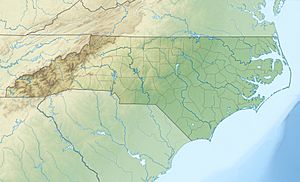Eagle Swamp facts for kids
Quick facts for kids Eagle Swamp |
|
|---|---|
|
Location of Eagle Swamp mouth
|
|
| Other name(s) | Tributary to Contentnea Creek |
| Country | United States |
| State | North Carolina |
| County | Lenoir |
| Physical characteristics | |
| Main source | Wheat Swamp divide pond at Hugo, North Carolina 22 ft (6.7 m) 35°23′26″N 077°31′52″W / 35.39056°N 77.53111°W |
| River mouth | Contentnea Creek Tick Bite, North Carolina 1 ft (0.30 m) 35°21′05″N 077°25′37″W / 35.35139°N 77.42694°W |
| Length | 7.38 mi (11.88 km) |
| Basin features | |
| Progression | southeast |
| River system | Neuse River |
| Basin size | 10.07 square miles (26.1 km2) |
| Tributaries |
|
| Bridges | Sharon Church Road, Skeeter Pond Road, NC 11, S Highland Avenue, Tick Bite Road |
Eagle Swamp is a small waterway, about 7.38 miles (11.88 km) long, located in Lenoir County, North Carolina. It is a "tributary," which means it's a smaller stream that flows into a larger one. Eagle Swamp flows into Contentnea Creek.
What is Eagle Swamp?
Eagle Swamp is a natural stream that plays an important role in the local water system. It's considered a "3rd order tributary." This means it's a stream that forms when two "2nd order" streams (which are formed by two "1st order" streams) join together. Think of it like branches on a tree, where smaller branches join to make bigger ones.
Where Does Eagle Swamp Flow?
The journey of Eagle Swamp begins in a place called Hugo, North Carolina. This is where the swamp "rises," meaning it's its starting point. From there, the water travels generally towards the southeast. Its path takes it through parts of Lenoir County. Finally, Eagle Swamp reaches its "mouth," which is where it flows into Contentnea Creek. This meeting point is near a community known as Tick Bite.
The Land Around Eagle Swamp
The area of land that drains water into Eagle Swamp is called its "watershed." This watershed covers about 10.07 square miles (26.08 square kilometers). Imagine all the rain that falls on this area; it eventually makes its way into Eagle Swamp.
On average, this region receives a good amount of rain each year, about 49.9 inches (126.7 cm). This rainfall helps keep the swamp flowing. About 15% of the land in the watershed is covered by forests. These forested areas are very important because they help filter the water and provide homes for many plants and animals. They also help prevent erosion and keep the water clean for the swamp and Contentnea Creek.



